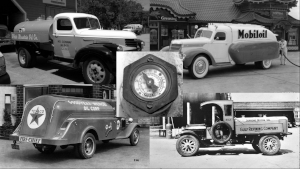In November 2019, the Governor of Nebraska received notification from the U.S. Department of Energy's Energy Information Administration (EIA) that the Midwest's distillate fuel stocks had been below the five–year average for more than three consecutive weeks based on the latest EIA data.
Winter Recap
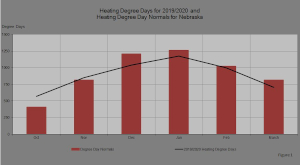
click/tap to enlarge
During the winter of 2019/2020, Nebraskans were continuing to recover from the impacts of a bomb cyclone and record snowfall (Winter Storm Ulmer) which crippled the state in March 2019. Nebraska had its worst flooding in 50 years and worst blizzard in nearly as many years.
Although many factors were at play during the 2019/2020 winter heating season, there were two major issues in the Midwest Region:
- On November 20, 2019, in accordance with the Reliable Home Heating Act of 2014 (RHHA), Governor Ricketts was notified by Linda Capuano, Administrator of the U.S. Energy Information Administration (EIA), it had been determined that stocks of total distillate fuel, including heating oil, had been lower than the five-year average in the Midwest for more than three consecutive weeks.
- The RHHA requires EIA to notify governors of affected states when regional stocks of heating fuels are lower than five-year average levels for more than three consecutive weeks. Because states use different sulfur specifications for heating oil, EIA uses total distillate fuel inventories to meet the requirements of the RHHA for heating oil.
- Mid-America Pipeline (MAPL) reported that their pipeline was on allocation of propane. MAPL prioritized propane in the pipeline; one batch line because MAPL didn’t want to disrupt supply of other fuels. Although Nebraska's propane price was not impacted by MAPL’s allocation, demand increased from other states’ truck drivers coming to the state for fuel. One state was Iowa. Iowa was suffering from MAPL’s propane allocation and needed additional fuel from surrounding states.
The 2019/2020 winter heating season, as a whole, saw warmer–than–normal winter weather. Looking at individual months, October and November had colder–than–normal winter weather as reflected by Figure 1. In fact, October was very cold. The month was 40 percent colder than an October with normal winter weather in Nebraska.
The traditional heating season for both heating oil and propane is October through March. From October through March, Nebraska normally has 5520 heating degree days. For this period during the 2019/2020 winter season, Nebraska had 5337 heating degree days which indicates that the weather was 3.3 percent warmer than normal. In Figure 1, the bars represent the heating degree day results of normal winter weather for each month in Nebraska. The line represents the heating degree day results of the actual weather that the 2019/2020 winter season experienced. The lower the number of heating degree days, the warmer the weather, and the fewer days Nebraskans had to heat their homes and businesses. October and November were colder than normal but the rest of the months show that they were warmer than normal.
With the cold snap in October and November, harvest overlapped the home heating season. According to the US Department of Agriculture (USDA), harvest began at the end of September and finished in December. Comparing the harvest season to the USDA’s “Usual Planting and Harvesting Dates by Crop” for Nebraska reflected that harvest began relatively on time but finished late.
As a result of the tight supply of distillate fuel in the Midwest Region and cold temperatures, the average price of heating oil was 25 percent higher than last season. Heating oil prices continue to be highly dependent on crude oil market movements. Propane prices are subject to both the volatility of the oil markets and natural gas production. Propane prices were 13 percent lower than last winter's heating season due to adequate stocks.
On November 1, 2019, the Federal Motor Carrier Safety Administration (FMCSA) issued a Regional Emergency Declaration followed by an extension that resulted in an expiration date of January 10, 2020. (The extension was due to the emergency conditions not abating.) The Emergency Declaration permitted commercial transporters of heating fuel to work extended hours in order to meet the urgent need for heating fuels in the region.
The Office of the Governor issued an Executive Order on November 21, 2019, to provide emergency relief and to supplement the FMCSA’s emergency declaration by easing hauling weight restrictions for carriers operating in Nebraska. The Order suspended weight limits (up to 90,000 pounds gross weight) for motor carriers hauling critically needed heating fuels on all highways within Nebraska, excluding the interstate system. The Executive Order was effective immediately and remained in place through December 15, 2019.
On November 19, the Federal Energy Regulatory Commission (FERC) initiated a discussion with pipeline companies, shippers, and their representatives to explore actions that could be taken to alleviate propane pipeline constraints in the Midwest. As a result, pipelines undertook certain actions to assist: on November 25, in order to bring additional propane supplies into the Midwest, Enterprise TE Products extended its transportation of propane into Chicago. ONEOK temporarily waived its restrictions against qualified shippers transferring allocated capacity to one another.
Three geopolitical issues that attempted to disrupt supplies in the 2019/2020 winter heating season were:
- The market experienced a supply disruption with the Philadelphia Energy Solutions’ (PES) refinery closure. The closure was brought on by a fire in June 2019. Pennsylvania’s Public Utility Commission ruled to allow shipments on the Laurel Pipeline into Western Pennsylvania beginning on October 1, 2019, which provided an additional source of diesel fuel into the East Coast.
- On September 14, 2019, an attack damaged the Saudi Aramco Abqaiq oil processing facility and the Khurais oil field in eastern Saudi Arabia. Saudi Aramco reported that its entire output capacity was expected to be fully restored by the end of September.
- A seven-day strike involving more than 3,200 Teamsters employees of Canadian National Railway ended with the railway resuming normal operations November 27. The rail strike didn’t affect short tankers from bringing propane from Canada to the US, but continued delays from the strike were experienced while a backlog of rail cars was resolved.
Purpose of Survey
The Nebraska Department of Environment and Energy (NDEE) collects data on residential prices of No. 2 heating oil and consumer–grade propane during the heating season (October to March) for the State Heating Oil and Propane Program (SHOPP) Survey. It is the only USDOE EIA survey that collects propane prices. The data are used by NDEE to monitor the prices of propane and heating oil during the winter season in an effort to maintain awareness of any price or supply irregularities that may be developing. The data is also used by policymakers, industry analysts, and consumers.
In December 2018, Congress endorsed a suite of major bipartisan data reforms for improved accessibility and protection for the data that government collects. The president enacted the provisions into law in January 2019. The USDOE EIA notified NDEE that anyone having access to the SHOPP survey and its results would need certification under the Confidential Information Protection and Statistical Efficiency Act (CIPSEA). Nebraska staff were certified before the 2019/2020 heating season.
Residential Propane
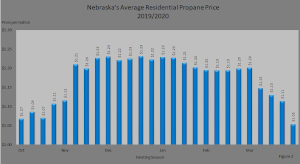
click/tap to enlarge
The price of propane is closely tied to the prices of crude oil and natural gas. Normal winter weather can also put extra pressure on propane prices during a high–demand winter season since there are no readily available sources of increased supply except for imports. Canadian propane supply is always reviewed due to the panhandle of Nebraska relying on Canadian imports. Exports are also a cause for concern for many although, according to EIA, there is more propane than needed for domestic use. EIA data for the beginning of the winter season (October 2019) showed that October's export of propane and propylene was 1,168,000 barrels/day. This was 26 percent higher than October's export in 2018 (928,000 barrels/day).
The average home heating charge price for delivery of consumer–grade propane, excluding taxes and cash discounts, in Nebraska for the 2019/2020 heating season was $1.17 per gallon. This was a 13–percent decrease from last season's average price at $1.34.
For the 2019/2020 season, the average retail price of propane started at $1.07 per gallon. The average price was relatively stable from October through the first week in November. The second week in November saw a nine-cent jump in price. From that week through the first week in March, prices were again stable. For the second week in March, the price fell a nickel and proceeded to fall each week until the price reached $1.05 per gallon at the end of the heating season. This price was relatively equal to (two cents lower) the price at the beginning of the heating season. Prices reported on the survey each week were dependent upon when a retailer bought a load of propane from their supplier. After buying a load of propane, the retail price would reflect the wholesale price paid. (See Figure 2.)
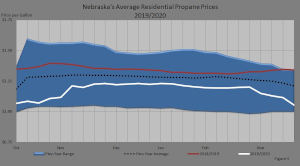
click/tap to enlarge
The average propane price began the 2019/2020 heating season at $1.07, 28 cents (21 percent) lower than the price of $1.35 at the beginning of the last heating season. As shown in Figure 3, the average propane prices in the 2019/2020 season were stable within the five–year range but lower than the five–year average and last year's prices.
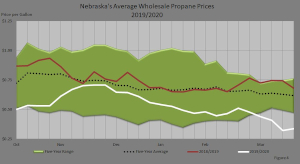
click/tap to enlarge
The average wholesale propane price began the 2019/2020 heating season at 50 cents, which was 37 cents (43 percent) lower than the price of 87 cents at the beginning of the last heating season. Average wholesale propane prices rose from October through the end of November and then declined until February. The price rose a total of 10 cents to 51 cents and then started its descent until the end of the heating season and finished at 34 cents per gallon. The price of 34 cents was 16 cents (32 percent) lower than the price at the beginning of the heating season (50 cents). As Figure 4 shows, the average price of wholesale propane stayed in the five–year range for the majority of the heating season. The average price was lower than last season's wholesale price and the five–year average the entire heating season.
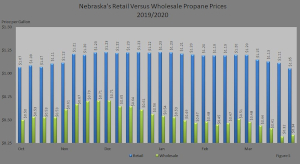
click/tap to enlarge
A comparison of average retail propane prices versus average wholesale propane prices in Figure 5 shows that retail prices during the 2019/2020 heating season ranged from a low of $1.05 to a high of $1.23, while wholesale prices ranged from a low of $0.32 to a high of $0.71. Retail prices are higher than wholesale prices since wholesale prices are a major component in retail prices. Retail prices also parallel wholesale prices due to this. Retail prices were stable while wholesale prices were more volatile in comparison although both prices had a narrow range between the high and low of the heating season. A narrow range indicates stability.
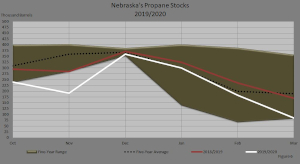
click/tap to enlarge
According to EIA, Nebraska's total inventory of propane was 240,000 barrels at the beginning of the heating season in October 2019, which was 55,000 barrels (19 percent) below propane stocks one year earlier. Stocks fell from October to November due to colder–than–normal winter weather. Stocks increased in December reaching into the five–year range. Through January, February, and March, stocks steadily declined yet stayed in the five–year range. (Figure 6)
Residential Heating Oil
The price of heating oil, being a petroleum product, is closely tied to the price of crude oil. Normal winter weather can also put extra pressure on heating oil prices during a high–demand winter season.
The average home heating charge price for delivery of No. 2 heating oil, excluding taxes and cash discounts, in Nebraska for the 2019/2020 heating season was $2.24 per gallon. The season's average price jumped 45 cents or 25 percent from last season's average of $1.79.
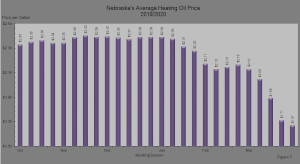
click/tap to enlarge
Figure 7 shows that the average retail price of heating oil started the 2019/2020 season at $2.33 per gallon. The price was stable from October through the second week of January. From then on, the price fell slightly each week–with a small increase at the end of February–until the end of the heating season. The price finished at $1.67 per gallon which was 66 cents (28 percent) lower than the price at the beginning of the season.
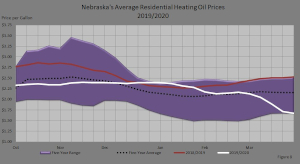
click/tap to enlarge
The average heating oil price began the 2019/2020 heating season at $2.33 per gallon, 44 cents (16 percent) lower than the price of $2.77 at the beginning of the last heating season. Average heating oil prices were stable from October through January. The price then declined steadily until the end of the heating season. As Figure 8 shows, the average price of heating oil took a sizable drop from last year's price at the beginning of the heating season although it was above the five–year average and in the center of the five–year range. Heating oil prices were stable through the end of January but the five–year range moved so that the price came up from center to the upper border of the five–year range. This also put the price above the five–year average and last year's price. From then on, the price slightly but steadily declined with a miniscule increase at the end of February. At the end of the heating season, the price was at the bottom of the five–year range and far below the five–year average and last year's price.
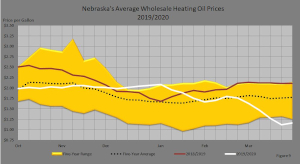
click/tap to enlarge
The average wholesale heating oil price began the 2019/2020 heating season in the middle of the five–year range and remained stable until the beginning of January. Through the end of December, the wholesale price was above the five–year range as the range took a short–term dip. From the beginning of January, prices fell with a slight increase through February. As Figure 9 shows, wholesale prices were far below last year's prices until December. The wholesale price was above last year's prices from then until mid–January. From then until the end of the season, wholesale prices were far below last year's prices. The average price of wholesale heating oil started the heating season at $1.99, which was 52 cents (21 percent) lower than the price of $2.51 at the beginning of the last heating season. By the end of the heating season, Nebraska's average wholesale heating oil price was $1.16, which was 83 cents (42 percent) lower than the price at the beginning of the heating season.
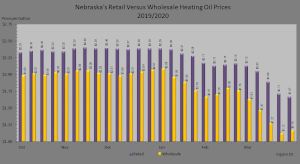
click/tap to enlarge
A comparison of retail heating oil prices and wholesale heating oil prices in Figure 10 shows that, during the 2019/2020 heating season, retail prices ranged from a low of $1.67 to a high of $2.40, while wholesale prices ranged from a low of $1.12 to a high of $2.08. Retail prices are higher than wholesale prices since wholesale prices are one component of retail prices. Retail prices also parallel wholesale prices due to this.
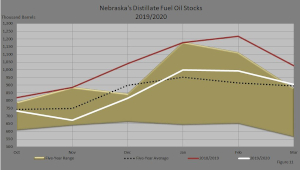
click/tap to enlarge
Figure 11 shows distillate stocks in Nebraska. Distillate stocks were in the range of 600,000 barrels to nearly 1 million barrels throughout the heating season. Stocks started the season in the upper five–year range but below the five–year average and below last year's inventory level. Following a very cold October and November, stocks fell to 673,000 barrels. Stocks increased hitting a high of 998,000 barrels in January and then fell slightly every month to the end of the heating season. The stock level ended the season at 895,000 barrels, which was above the five–year range and equivalent to the five–year average. The stock level was in the five–year range all through the heating season until the end when it settled above the five–year range. Last season's stock levels were pretty much unattainable staying above the five–year range throughout the season.
Sources: State Heating Oil and Propane Survey and the Weekly Petroleum Status Report. Energy Information Administration, Washington, DC. Nebraska Department of Environment and Energy, Lincoln, NE.
This report was completed November, 2020.

